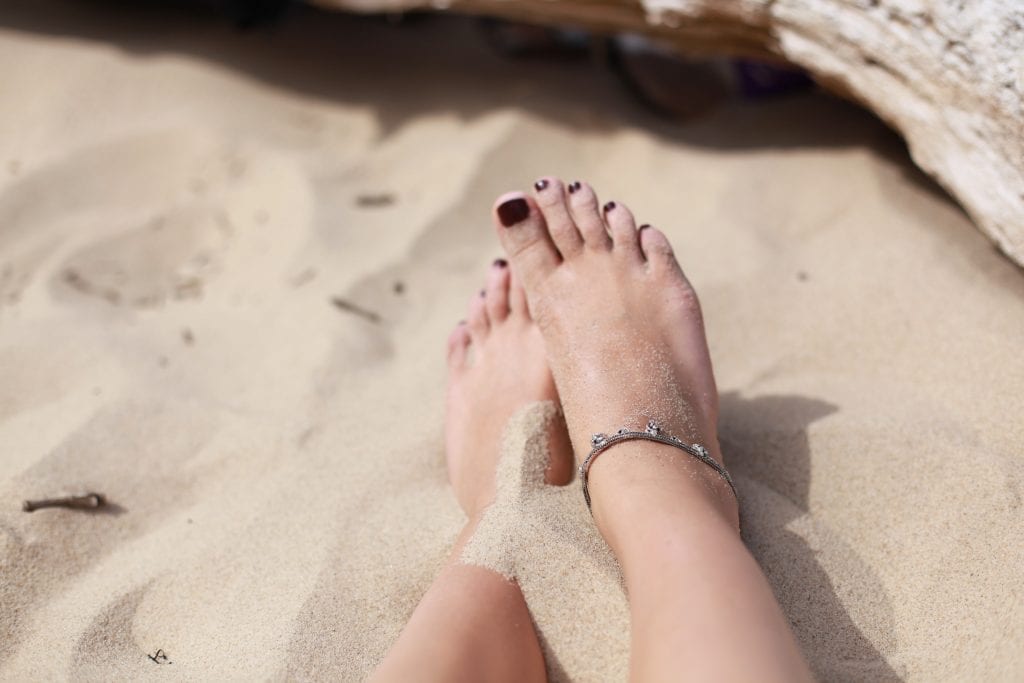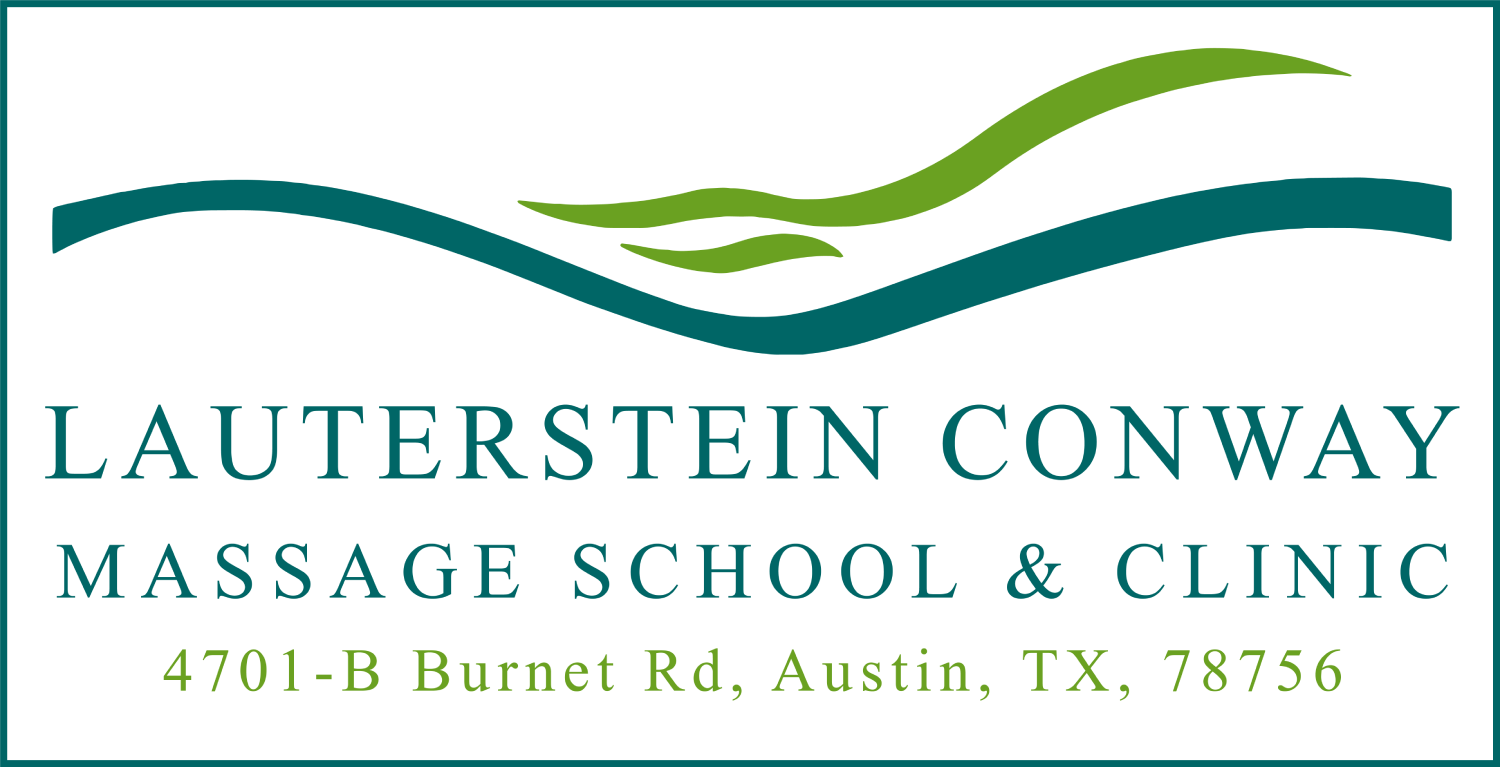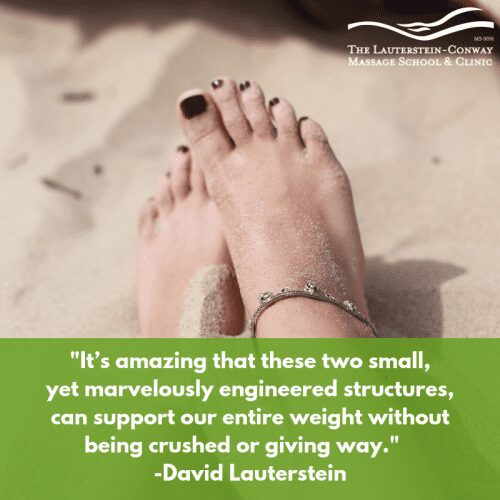Massage Education for the Feet, A Foundation
There are 206 bones in the body, 52 of them are in the feet!
It’s amazing that these two small yet marvelously engineered structures can support our entire weight without being crushed or giving way. It’s little short of miraculous that they also constantly balance out the infinite varieties of motion going on in the body above them.
PICTURE THE BONES
First, picture the bones of the lower leg and ankle. The shinbone – the stoutest in the body – is the tibia. Along the outside of the tibia runs the fibula. It also enlarges around its bottom to form what we think of as the outer “ankle bone”. The tibia is the main weight-beating one of the foot. It rests in turn on a bone which comes between it and the heel – called the talus. The talus looks like a flattened hammerhead facing forward. Ankle movement largely takes place between the tibia and the talus. The heel bone, the calcaneus, is the largest and strongest bone of the foot. Side-to-side movement of the foot happens largely at the joint between the talus and calcaneus. In front of the heel are two bones which help transmit the body weight through the inner and outer arches of the foot. These are the navicular and the cuboid. In front of the former are the 3 cuneiform bones. Beyond these and the cuboid lie the 5 long metatarsals. And, beyond these, the phalanges, better know as the toe bone or “tootsies!”
THE ARCHING OF THE FOOT
So what are the arches exactly? Please note the arches are not things, arching is something the nerves, muscles, ligaments and bones of the foot cooperate in doing. Looking at the inner longitudinal arch – this arch is sustained by the soft tissues which run on the underside of the foot from the heel to the toes. As these muscles contract, they bow the arch of the foot; much as tightening a bow string increases the curve of the bow. Often problems arise here when we wear shoes which restrict our feet so that their movement actually is more like hooves. The delicate muscles of the foot, being asked neither to lengthen nor shorten much, become stuck at one length. Thus, stuck the foot loses some of its capacity to arch and body loses some of its spring.
When working well, the muscles on the underside of the foot are the bow strings which bend the arch and our body and the arrow which the foot propels up and forward. But when is the last time you felt that? Try to imagine this – it can give you quite a lift!
THE MIRACLE OF BALANCE DEPENDS ON THE FOOT
 The most true-to-life visualization of the foot and its arching is of a three-poled geodesic dome tent. In the tent, as in the foot, the lift and balance is essentially provided by tensions in the soft fabric, the muscles, fascia and ligaments. But the foot is a tent, which can also move of its own accord. Moreover, the foot is a tent moving of its own accord, which just happens to also be the base of a geodesic Eiffel Tower. This tower is the rest of the body, which itself is moving and gyrating around on its own. Now is this not a miracle indeed?
The most true-to-life visualization of the foot and its arching is of a three-poled geodesic dome tent. In the tent, as in the foot, the lift and balance is essentially provided by tensions in the soft fabric, the muscles, fascia and ligaments. But the foot is a tent, which can also move of its own accord. Moreover, the foot is a tent moving of its own accord, which just happens to also be the base of a geodesic Eiffel Tower. This tower is the rest of the body, which itself is moving and gyrating around on its own. Now is this not a miracle indeed?
MASSAGE IS NEEDED FOR HEALTHY FEET
Here are some ways you can use touch to respect these little miracles:
Massage: There are 4 layers of muscle on the bottom of the feet. Considering the compression from bearing the body’s weight and the lack of movement from being continually shod, and the impact of walking and exercising so often on hard floors, the muscles layers tend to get impacted on one another. Fibers between and within muscles become stuck together, through adhesions. Frequent massage can relieve adhesions and restore free movement to the layers of muscle, fascia and bones of the foot. First, visualize the longitudinal arches and work your from the heel to the toes exploring for places in the foot which are hardened or immobilized. Use your thumbs, fingers, or knuckles, with gentleness yet depth, to teach these places to become more yielding. Next, picture the traverse arch and massage similarly across the width of the foot. Then feel for the metatarsals, the long bones preceding the toes. Lift one up and the next one down until you’ve reminded each of their independence. Then massage each toe, trying to remind the toes that they are composed of delicately interlocked segments and are not just idle stubs. Explore the top of the foot. Work thoroughly all around the ankles. Many muscles, which originate in the lower leg, pass in front or in back of the ankle on their way into the foot. As they curve around the ankle, these muscles often adhere to one another or to the underlying ligaments or bones.
THE FOUNDATION FOR OUR WHOLE SELF
Recognize the importance of the foot as the anatomical foundation of the body. It is also fundamental to the body’s other physiological and energy systems. Being grounded is an energetic role of the feet and of course reflexology posits connections to every single organ from the feet.
We spend too much daily time in our heads! Let’s go to the feet. There we can find relief and balance. They have so much to teach us. And we owe them a debt of enormous gratitude and kindly attention for what they do for us every day.
*******************
On January 20th, The Lauterstein-Conway School will be hosting a special reflexology workshop . It is taught by one of the pioneers in Texas massage, Marsha Walker, Phd. in Holistic Nursing and author of “HEALING MASSAGE”. She has been in practice as a reflexologist, massage therapist, and energy worker for 40 years and brings all that knowledge and experience into her brilliant teaching.


